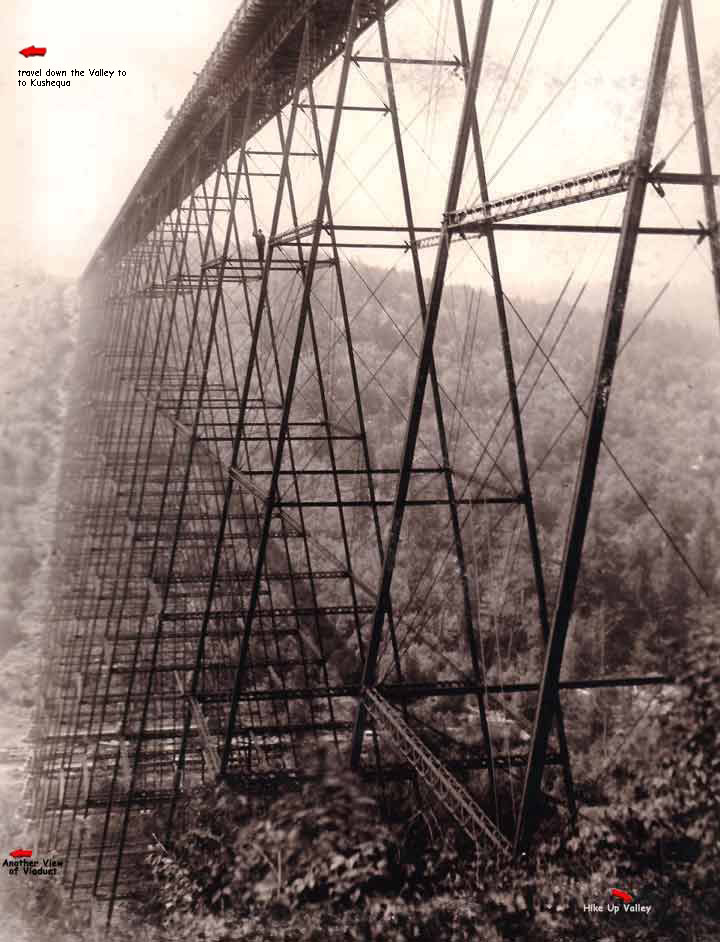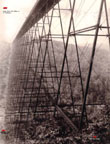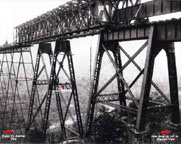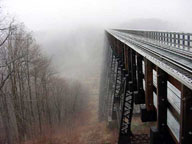The History of the Kinzua Viaduct

photo credit: R.C. Gleason
Collection
The History of the Kinzua Viaduct

photo credit: R.C. Gleason
Collection
In the 1800's the abundant natural resources of north central Pennsylvania attracted many men seeking challenge and fortune. The region's vast forests rapidly fell to the ax and two man crosscut as railroads carried millions of board feet of timber to waiting sawmills. Chemical plants and tanneries consumed countless railroad carloads of hemlock bark and cordwood.
The state's rich deposits of the fossil fuels oil, natural gas, and especially coal were important to the nations growing economy. Railroads carried the coal that fueled the fires of industry, heated homes, and powered the trains themselves. Rapid industrial growth around the Buffalo, New York, area produced a high demand for coal. By 1880 Buffalo was using around three million tons of coal a year. The city's location on the Great Lakes also made it a center for shipping of coal to other industrial areas in mid America. However, between Pennsylvania's coal deposits and the awaiting industry to the north and west lay an obstacle, the Kinzua Valley.
The New York, Lake Erie, and Western Railroad and Coal Company recognized the profits to be gained by transporting coal across the Kinzua Valley instead of taking the six mile route around the Kinzua Valley to waiting markets in Buffalo. Company president General Thomas Kane, of Civil War fame, and brilliant civil engineer Octave Chanute together faced the challenge of the Kinzua Valley. Mr. Chanute lived from 1831 until 1910 and was the inventor of call ties and date nails, which had the date engraved on them. He was also responsible for the preservation of timber by he the creosote process. They decided that building a viaduct directly across the valley would be the best option.
Chanute awarded the bid to The Phoenix Bridge Works Company. General Kane met with Anthony Bonzano of the Clark Reeves Division of the Phoenixville Bridge Works Company of Phoenixville, Pennsylvania, in early 1882. Mr. Bonzano told General Kane, "We'll build you a bridge a thousand feet high if you'll provide the money." Anthony Bonzano along with Oliver W. Barnes, who was the chief engineer for Kane's railroad, joined up and planned the first Kinzua Viaduct. Work on the stone piers began in 1881 and took six months to complete. The massive sandstone blocks used to make the stone piers that support the extremely high iron columns were quarried from the nearby hills. They are in great supply and of an excellent quality. There were 7,600 cubic yards of hard sandstone used in the stone work of the viaduct. The stone piers were embedded as far as thirty-five feet below the ground and as high as sixteen feet above the ground. John C. Noaks was in charge of the stone work for the first viaduct. There were bolts that measured six to ten feet long and one and a half inches in diameter embedded in the 110 stone piers for the attachment of the vast amount of iron work. On September 8, 1881, the cornerstone of the Kinzua Viaduct was placed on the south abutment, where it remains today.
Erection of the ironwork began on April 10, 1882. There was a temporary railroad track laid into the valley to assist the workers on the bridge in the distribution of the large amount of iron work. The Kinzua Viaduct was constructed of stone and iron completely with the only wood being the railroad ties and railings. There were twenty lower spans of thirty-eight and one half feet, and twenty-one intermediate spans that measured sixty-one feet. The tubular wrought iron columns, which measured nine and three quarters of an inch in diameter, resembled logs and led to the mistaken belief that the bridge was constructed of wood. Tie rods were used to aid in the stability of the bridge. There was no scaffolding used in the construction of the bridge. All that was used was a rig called a gin pole to build the first tower and after that a wooden crane was built at the top of the first tower and the second tower was built using the crane. This process was repeated to construct the rest of the towers. There was also two steam hoists used to aid in the construction of the viaduct. Amazingly there was thirty miles of manilla rope needed for the tackle and block used. In 94 working days the 40 man crew had completed the highest and longest railroad bridge ever built. It was 301.5 feet high and 2,053 feet long with the tallest tower having a spread of 103 feet. The thirty-six workers were paid two to three dollars a day and the four foremen made five to six dollars a day. The total cost of the original structure was $167,000 and contained 3,105,000 pounds of Iron.
The original Kinzua Viaduct was advertised as the eighth wonder of the world. People from all over the civilized world came to see this engineering marvel of it's time. Excursions came from as far away as Buffalo and Pittsburgh for a around a dollar per person. On a typical summer Sunday of the time it was not rare to see six to eight excursion trains of ten to fourteen cars to cross the viaduct. To cross the viaduct was considered a great thrill at the time. Drinking, gambling, and parties were a common occurrence on these early excursions to the viaduct. Many excursionists would even try to climb the iron work of the viaduct. However, many of them would only end up needing rescued from the high iron girders after they found they could not climb back down. These excursions to the Kinzua Viaduct were very popular and raised more than enough money to offset the 167,000 dollar cost to build the original structure. The last excursion over the Viaduct took place just before the United States entered World War One.
Concerns about the bridge's safety were somewhat relieved when the structure passed safety inspections and then survived an 1889 train crash. In July of 1889 Conductor Keily's train, bound south, separated on the viaduct, the locomotive and attached cars reached Mount Jewett before fourteen cars were missed. The engineer at once backed down the tracks and when he was near the bridge brake man Ryan discovered the conductors signals. The engineer reversed his lever, and at once a coupling snapped and three cars went thundering down grade. At the bridge there was a terrible crash and three cars were converted into wood splinters some 301 feet below the bridge. If the cars had gone over the sides of the viaduct there is little doubt regarding the damage which would have been caused to the structure.
High winds sweeping up the valley caused the flexible bridge to sway and sometimes even blew loads of hemlock bark off the railroad cars. The wind even blew the roofs off of box cars. Trainmen even told of times when it was impossible to stand upright on the deck of the viaduct. The strong winds blew the second viaduct two and seven eighths inches out of line within one year of it's construction. Train speeds were limited to 5 miles per hour while crossing the valley.
Charles P. Stauffer, the original bridge inspector, climbed over and inspected three of the towers every day. Since there were twenty towers altogether he would be able to inspect the entire system of piers and braces in one week. Stauffer would even climb the viaduct with his son on his back to thrill the excursionists. Once, in the winter of 1883-84, while making his usual inspection, he fell a distance of sixty-five feet. The cold winter air numbed his hands so that he could no longer cling to the frigid iron braces. Fortunately he fell into about ten feet of snow, which broke his fall, or else the company might have been forced to look for a new man. He said he only missed striking a stump by a few inches. Another narrow escape he had, was when he was climbing over the top girts one day and someone hailed him from above. It startled him and in a sense he forgot where he was. He let go of his hold and was instantly falling to the ground. By a great effort he was able to grab hold of one of the iron braces just in time to save himself. However, in 1899 he fell sixty feet, which resulted in a fatal injury to himself.
In May of 1900, after only eighteen years of use, it was necessary to rebuild the entire structure to accommodate more weight and not because of any flaw in the prior construction. A new and sturdier structure was required to withstand the incredible weight of new trains and rolling stock. All traffic was prevented from crossing the viaduct on May 14, 1900, although the actual reconstruction did not begin until May 24, 1900. The last girder was up in place on September 6, 1900 and traffic began to cross the Kinzua Valley over the new viaduct on September 25, 1900. The job was completed in 105 days by about 100 to 150 men working ten hours a day. This in itself is impressive because during the construction there was a week long strike, the speech of a presidential candidate in the area, and a major forest fire that began under the viaduct and burned two communities before being stopped at the edge of a third community. The new steel viaduct had the same measurements, but now weighed an impressive 6,715,000 pounds. The construction of the new viaduct was directed by C.W. Bucholz the chief engineer of the Erie and was carried out by the Elmira Bridge Company.
The construction started on both ends and they worked towards the middle of the viaduct and with the use of two 180 foot timber travelers, which were both a complete Howe truss, that measured 16 feet in depth. The timber travelers spanned three towers and the middle tower was destroyed and then reconstructed of new steel and after the tower was finished the timber traveler moved on to the next tower and repeated the process. The skilled workers were able to move at a rate of 500 feet per month. They were able to demolish the highest tower and the adjoining spans in seven and one half days. There were thirty seven miles of rivet rod used in the construction of the second structure. Andy Stauffer, the son of the late bridge inspector Charles P. Stauffer, received the honor of removing the first bolt from the original structure and then driving the final gold rivet into the new viaduct.
The new viaduct's supporting posts were of plate and lattice construction with measurements of twenty-four by thirty inches. The old structure's lattice work spans were replaced by girders. They measure five and one-half feet deep at the tower tops and six and one-half feet deep in the spans between the towers.
Octave Chanute played a role in the engineering of both structures. He solved the problem of wind stress on the second structure by designing it to hold up against fifty pounds of pressure per square foot when unloaded and thirty pounds per square foot when loaded. The smaller pressure for the second figure was due to the fact that a pressure of thirty pounds to a square foot would be enough to blow a train off of the structure.
After the erection of the second structure, the viaduct was painted on an average of every seven years. The original stone piers of the viaduct were encased in concrete between the years of 1907 and 1933. The first diesel train crossed the viaduct in April of 1949.
The Kinzua Viaduct has several interesting stories in its past. It is said that in 1901 two thrill seekers climbed onto the cap strips of the guard railings, which were four inches wide, and while keeping abreast crossed the viaduct some 305 feet above the Kinzua Creek. There is also record of two other people that accomplished this daredevil feat. Perhaps the most interesting story behind the Kinzua Viaduct is one that still attracts treasure hunters to this area. The legend states that a bank robber hid $40,000 in gold and currency in glass jars under a triangular shaped rock within sight of the viaduct at the turn of the century. The treasure has not been recovered to this date.
There was no train traffic on the Kinzua bridge from June 21, 1959 till 1987. The Kinzua Bridge was made a state park in 1963. On August 12, 1963 at 2:30 p.m. Governor William W. Scranton placed his signature on a bill in Harrisburg, Pennsylvania authorizing Pennsylvania's purchase of the world renowned Kinzua Viaduct. The Kinzua Viaduct and surrounding area had now become the Kinzua Bridge State Park. The park officially opened in 1970. The bridge received even more recognition in 1977 when it placed on the National Register of Historic Civil Engineering Landmarks. At 11:00 a.m. on July 31,1987 Earl T. Kilmer and engineer Charles Cambell made the first trip across the Kinzua Viaduct since June 21, 1959. The rode Diesel #1 which was pushing six to seven hopper cars and one flat car. The hopper cars were carrying forty tons each. They crossed the viaduct at a speed of three miles per hour. From Mr. Kilmer's experience, the ride that cost him ten cents was very exciting and smooth. The first passenger train to cross the Viaduct was Engine 1923 of Baldwin Locomotive Works in Philadelphia, Pennsylvania. The train crossed the viaduct in August of 1987. This train ride was by invitation only and it concluded with the breaking of a bottle of orange soda on the striker plate of the chair car.
In 1986 The Knox, Kane, Kinzua Railroad was formed. They offer excursion rides from Marienville to the Kinzua State Park. The history of the bridge is revived with the 97 mile round trip. The excursion train crosses the bridge and turns around on the other side, giving the passengers a truly astonishing view of the Kinzua Valley.
The Kinzua Viaduct is believed to be the second highest viaduct on the North American continent. However, it is doubtful that any viaduct of it's type surpasses it in both length an height. To this day the Kinzua viaduct remains both an engineering marvel of its time and a major tourist attraction to thousands of people a year.
 1883
Kinzua Bridge 1883
Kinzua Bridge |
 1900's
Kinzua Reconstruction 1900's
Kinzua Reconstruction |
 2000
Kinzua Bridge 2000
Kinzua Bridge |